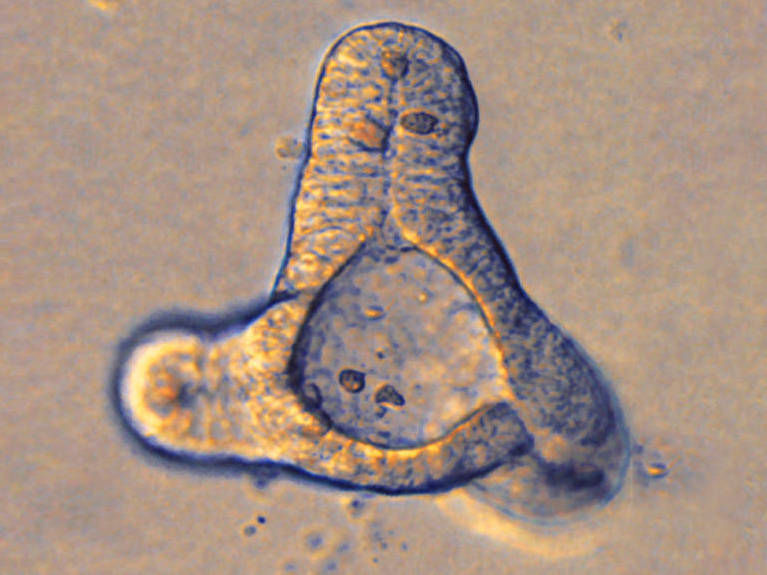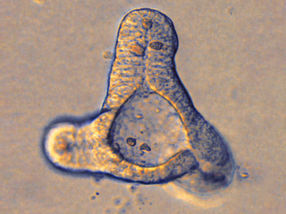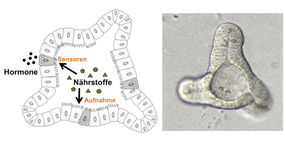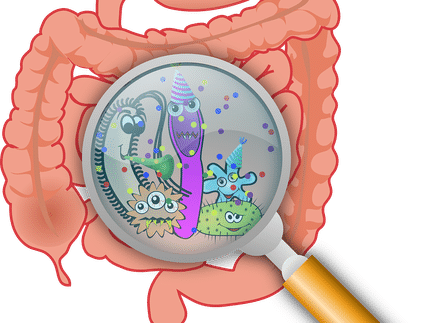Mini-intestine grown in a test tube
Organoid exhibits essential functions of a real intestine
Advertisement
The ability to grow three-dimensional precursors of an organ from stem cells in a Petri dish has brought about a revolution in the field of biomedicine. But exactly what can be researched on such an organoid in vitro? A team from the Technical University of Munich (TUM) has now shown for the first time how artificially grown mini-intestines can be used in nutritional and diabetic research.

Organoids just a quarter of a millimeter across exhibit functions of the human intestine.
TUM/ Zietek

The diagram shows on the right side a mini-intestine grown in a test tube and on the left you can see how it works.
TUM/ Zietek


Research efforts on the intestine have increased in recent years. Owing to its enormous surface area – comparable to that of a one-bedroom apartment – and the huge number of neurons it contains – comparable to that in the brain – the intestine is sometimes referred to as the abdominal brain. In addition to absorbing nutrients from the foods we eat, it influences our immune status and metabolism. With the help of sensors, specialized cells in the intestinal wall determine which hormones, if any, should be released into the bloodstream. Overall, it acts as a highly sophisticated control center.
How an organoid grows from cells
Among their many functions, intestinal hormones, known as incretins, control blood glucose levels, appetite and fat metabolism. Diabetics and obese individuals have already been successfully treated with drugs based on the mechanisms of action of these hormones. However, still too little is known about the precise mechanism behind incretin release.
Applying a new method that is used mainly in stem-cell research and regenerative medicine, researchers from the Technical University of Munich have now devised a robust intestinal model for molecular research into incretin release in a test tube (in vitro). To do so, they first isolate small pieces of intestine containing stem cells – in this case from mice. In the next step, a nutrient solution in a test tube stimulates the stem cells to develop into an organ-like structure. In just a few days, a spherical organoid forms that measures just a quarter of a millimeter across and is suitable for use in research.
Mini-intestine functions like normal intestinal tissue
“The special thing about our scientific work on the intestinal organoid is that we can observe its inner workings,” explains Dr. Tamara Zietek of the Department of Nutrition Physiology. “The mini-intestines exhibit all the essential functions of a real intestine,” the TUM scientist adds.
The intestinal organoid can:
- actively absorb nutrients and drugs
- release hormones after activation by nutrients
- transmit signals within the intestinal cells to control these processes.
“Until now, it was not possible to investigate these processes in a single model, because conventional models are unsuitable for all these measurements,” says Zietek, the corresponding author of the article that appeared in Scientific Reports of the Nature Publishing Group. In addition, once mini-intestines have been grown, researchers can work with them for months, because they can be replicated in the laboratory. “This drastically reduces the number of experimental animals needed,” says the scientist.
Interdisciplinary collaboration
Zietek developed the method in collaboration with Dr. Eva Rath of the Department of Nutrition and Immunology. Working on an interdisciplinary basis, the two scientists have combined organoid cultivation with molecular nutritional research. They are now demonstrating that the mini-intestine is an ideal model for investigating hormone release and transport mechanisms in the digestive tract. “This is a huge advance for gastroenterological basic research as well as biomedical sciences and pharmacology,” Zietek believes. The next step will be to work with mini-intestines grown from human intestinal biopsy material. “We’re already in contact with a hospital that can provide the required research material.”In view of the growing number of diabetics and obese individuals, this method can help nutritional researchers develop new forms of treatment.



























































